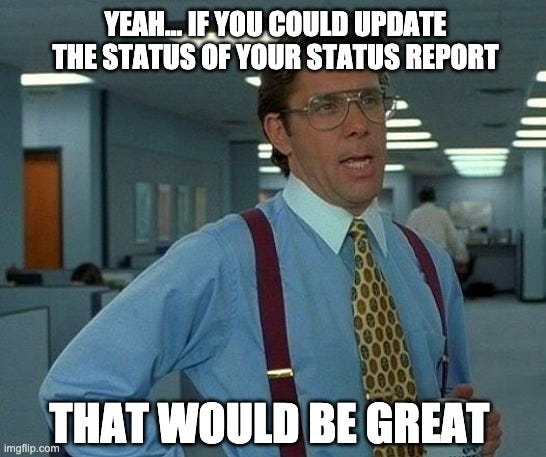Creating Trust Through Product Reviews
Moving from bland status updates towards continuous feedback loops.
We all love to hate project status updates. Sure, they serve a purpose, offering a snapshot of progress; however, hey often feel like a burdensome task, lacking depth and failing to truly engage stakeholders.
Despite this, stakeholders demand them for the sake of transparency, tracking progress, and seeking assurance that their favourite projects are on track.
However, to truly foster trust with stakeholders, product managers must go beyond mere one-way status updates upon demand. They must transition towards continuous feedback loops, involving stakeholders throughout the journey, from Discovery to Delivery.
For Discovery:
Involving key stakeholders during collaborative design kickoffs is essential. This collaborative approach ensures that diverse perspectives are considered, leading to more robust solutions.
I've previously delved into the importance of conducting collaborative feature kickoffs in a separate post: check it out here!
For Delivery:
Product managers must excel at providing transparent product updates. These updates should not only track delivery progress but also showcase the value of the product work.
Stakeholders need to see how insights and data have informed product increments, driving tangible customer and business value. This is where mastering the ceremony of a Product Review becomes crucial.
The Case Against Status Update Reports
Status reports indeed provide a snapshot of work being completed and deliverables shipped, but there are certain limitations for these kinds of reports. These include:
Static Information: While product status reports offer a snapshot of the project at a specific time, they overlook the rapid changes inherent in product development. This oversight can result in stakeholders lacking an accurate understanding of the project's current state.
Lack of Context: Status reports often concentrate on metrics and milestones, neglecting to provide adequate context. This omission can lead stakeholders to misinterpret the reported status or its implications for overall project goals, hindering effective decision-making.
One-Way Communication: Traditional status reports serve as one-way channels, delivering information to stakeholders without encouraging feedback or collaboration. This limitation restricts stakeholders' ability to ask questions, voice concerns, or offer insights that could enhance project outcomes.
Oversimplification of Complexities: Product development involves navigating various complexities, such as market changes and technical challenges. Status reports may oversimplify these complexities, resulting in an incomplete understanding of progress and risks.
Focus on Outputs over Outcomes: Status reports often prioritize outputs like completed features rather than outcomes like customer value. This emphasis can disconnect reported progress from the project's strategic objectives, leading stakeholders to prioritize activities that don't align with goals.
Executives often demand written executive summaries so that they can have a sense of control and predictability into deliverables. However, in Product, especially in industries with high technological change, predictability is a pipe dream!
Instead, we need to review how we can improve the sphere of communication impact in a cadence that is aligned with how value is being created by the rest of your organisation.
Benefits of Effective Product Reviews
From my time in early-stage companies through to large scale enterprise, I see the following themes of benefits that result from conducting effective recurring reviews
Align: ensuring product efforts match strategy, boosting stakeholder confidence and project alignment.
Resolve: tackling issues, risks, or roadblocks, ensuring smoother progress and timely solutions.
Educate: informing stakeholders on project progress and impact, aiding informed decision-making.
Enable: offering guidance on deployment and go-to-market activities, empowering stakeholders to support product rollout effectively.
Collect: gathering feedback at each stage, enhancing evidence guided decision-making and final deliverable quality.
Celebrate: acknowledging achievements, fostering team pride and providing visibility into future business impact.
Note that these kinds of meetings should not be used as forums for decision making on execution details. Consider engaging stakeholders through continuous discovery instead, where you bring your stakeholder along the journey as you build, measure, learn and test your solutions.
Figuring Out Your Update Cadence
We’ve all been there:
Responding to daily questions about product status too frequently, and you will feel overwhelmed with no time to perform the actual product execution needed.
Updating stakeholders too late, and you’ll receive complaints that your team isn’t transparent or involving enough.
PMs are also busy continually crafting their narrative of the bigger picture as well, giving little room to report findings at a more frequent timeframe. Whether you’re creating yearly strategy reviews, updating quarterly roadmaps, or prioritizing initiatives monthly, PMs often have little room for reporting findings at a more frequent timeframe.
For me, updating stakeholders every 3 to 6 weeks strikes the ideal balance, allowing teams ample time to deliver value. This timeframe accommodates reporting insights from discovery and research, as well as sharing delivery progress, including lessons learned and impacts gained from product experiments or launches.
For instance, if you operate on 2-week sprints, you can choose to conduct Product Reviews every 4 weeks (equivalent to 2 sprints) or every 6 weeks (equivalent to 3 sprints), allowing for a comprehensive assessment of progress and insights gained.
The Elements Of Effective Product Reviews
There are many different formats you can use for your reviews. As each company has its own different culture, I can’t recommend a single method for you to use, but what I can do is list out some key components that reviews should have to ensure the benefits listed above. These are:





